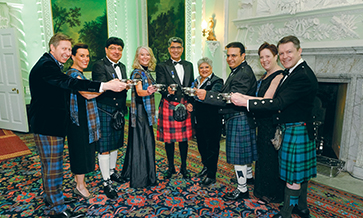Anjali Batra spoke about how, in recent years, the spirits category was witness to collaborations, rather than competition, to boost product innovation, even involving cross-industry tie-ups. But are they just one-off, or are they something that we’re likely to see in future too?
Heemanshu felt that until now it was always about competition, market share in the premium category or prestige category, and how brands would tackle it. “Today, if you are looking at expanding the market, collaboration is one of the drivers,” he said.
Anjali spoke about a “very beautiful example of collaboration” between Greater Than gin and Sleepy Owl coffee. Arman Sood he had two reasons for getting this done: “You get to research and work together on building a new product from scratch; and you put something out in the market that India hasn’t seen before!”
He said that when you push the envelope as collaborators it really shows how far the industry can go when players and partners come together. “It’s been an exciting journey!”
Anjali indicated that during the lockdowns of the Covid-19 pandemic several silent and public collaborations were under way. She spoke about two cultures coming together to build a larger community, as in the case of Stranger&Sons (India) and Four Pillars (Australia).
Silent partnerships
Rohan said members of the Indian Flair Bartender’s Association silently went about bringing material assistance and monetary relief to the hundreds of bartenders rendered jobless.
He added: “Everybody wanted to do something about it, helping in whatever way. One liquor brand started a fundraiser; we even had people from the coffee, tea and non-alcoholic mixer sectors coming together to help.”
Kasturi threw a few questions on the topic. When one collaborates with a person or a brand the objective has to be very clear. Are you doing it for publicity? Are you trying to do good work? Are you trying to help a community? Or are you trying to raise funds?
“During the pandemic as a brand we tried to help the bartenders in terms of up-skilling: teaching them photography, or helping them update their CVs. Because we believed that when life returned to normal, when employment resumed, they would be ready to get jobs,” she said.
“During Pride Month there are people who are not so comfortable coming out in the open; but we do stuff with them silently. I think collaboration should benefit everybody,” she said, adding that being a part of the Brews&Spirits Expo was a part of collaboration too.
Honest intentions
But why do brands collaborate? Rakshay has done a lot of such projects with his Pass Code Hospitality. “We did a jamun-ginger ale with Svami. We also launched India Cocktail Week, where we decided to showcase large-scale events that focused on cocktails throughout the country,” he said.
Coming to his spirits business (Pistola Reposado), Rakshay believes “a great friend of mine”, Desmond Nazareth (Agave India), had the infrastructure, bandwidth and time to take on certain significant roles – and hence the collaboration.
But what about established brands sharing the ICW platform? Wasn’t there a backlash? “Although it was a David versus Goliath scenario, there was no backlash,” Rakshay insisted.
All the participating companies really embraced the challenge of being able to compete on level playing field; and some of the really innovative, cool and fun stuff is being done by home-grown brands that have a great connect with the consumer.
“I get the sales report at the end of the show, so I know which brands really do well. It was shocking to see smaller brands compete with global giants and some of them outperforming the biggies!” Rakshay remarked.
Bar bells
Since Rohan is from the other side of the counter, Anjali asked him about how collaborative platforms are building healthy competition at the bar.
“Earlier, every company wanted exclusive space in the bar; they would want their own events rotating around a brand. The scene has changed drastically, where competitors rub shoulders in the same space,” Rohan said.
“Most importantly, such collaborations are a win-win proposition for the consumers; and bartenders are being encouraged to innovate,” he added.
Heemanshu had another proposal up his sleeve. “Today, we are still building for the world the Indian single malt category and that’s where we can work together. Perhaps the Indian gin and rum players can take a cue from this,” he said.
“When we participate in international fora, such as a Whiskey Live or a Whiskey Exchange show in London, we should be next to each other because we are building the Indian single malt category space,” he said.
“When we are together, you are sending out a clear signal to the customer that we are here as an industry. That would be our first point of collaboration!”
For the full panel discussion, visit Brews&Spirits Expo on YouTube.
https://www.youtube.com/watch?v=3jnWpEItfi8&t=6s













